How does the computing power network work?


In the previous articles, I gave you a detailed introduction to the nature of and Hash network . Today is the last issue of the computing power series. Let's take a detailed look at the networking architecture and technical system of the computing power network.
The architecture of the computing power network
As I mentioned before, the role of the computing power network is to provide users with computing power resource services. It completely "integrates" computing resources into the communication network, and provides computing resources services that best meet the needs of users in a more holistic form.
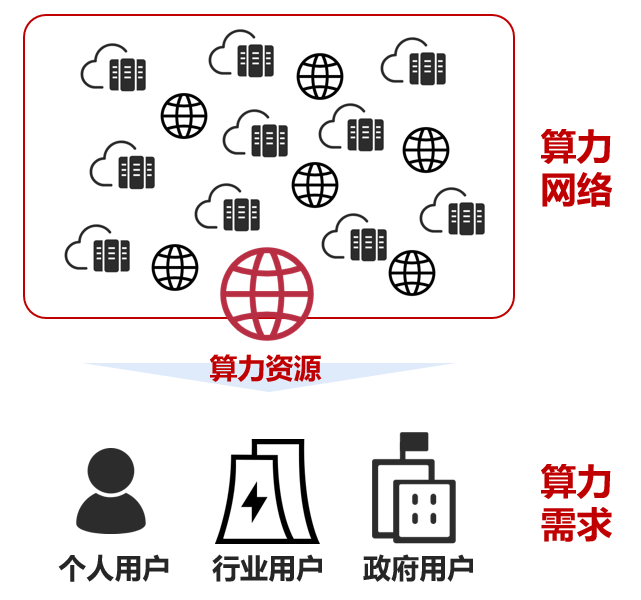
This is a highly flexible, highly intelligent network.
The core feature of the computing power network is that it realizes the full takeover of computing resources and network resources through computing power, allowing the network to perceive the computing power needs of users and its own computing power status in real time. After analysis, the computing power network can schedule different locations and different types of computing resources to serve users.
We can understand it as a "universal faucet". It can always provide the water flow with the right strength, the right temperature, and the right pH according to your needs, so that you can have the best water experience.

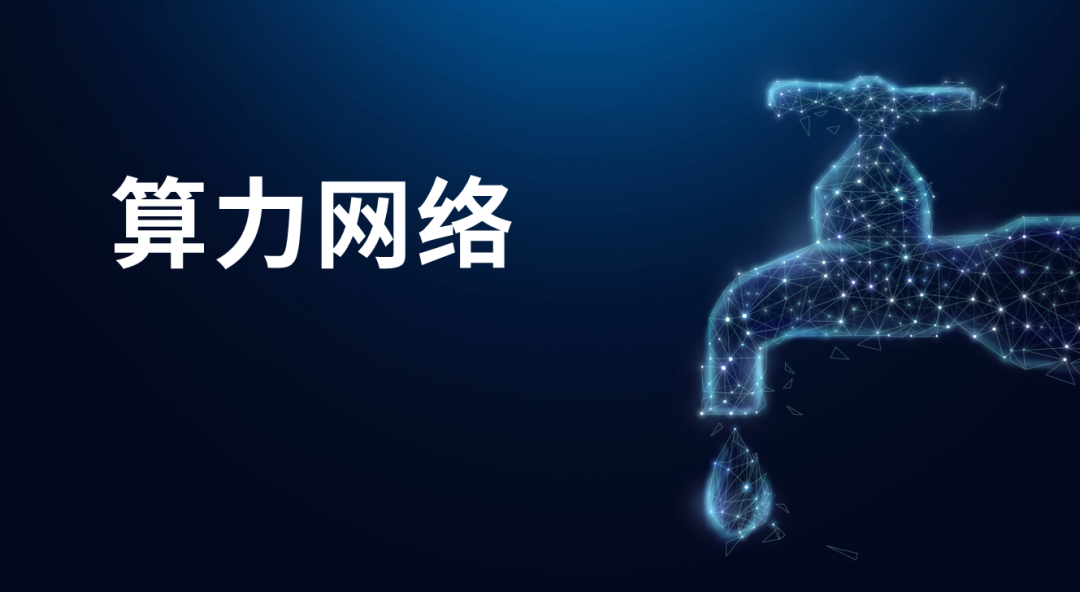
Then, we are naturally curious, what kind of "water net" is behind this "universal faucet"? How does it perform resource control and scheduling?
Next, let's take a look at the architecture of the computing power network.
First of all, I need to explain in advance that the computing power network is still a technology under research and has not been fully finalized. Therefore, what I give below is only the computing power network architecture (assumption) diagram of each operator and equipment manufacturer, and there will be certain differences between them. Moreover, it is very likely that changes will occur in the future, so please be aware.
The following pictures are the representative computing network architecture (assumption) diagrams of operators and equipment manufacturers:
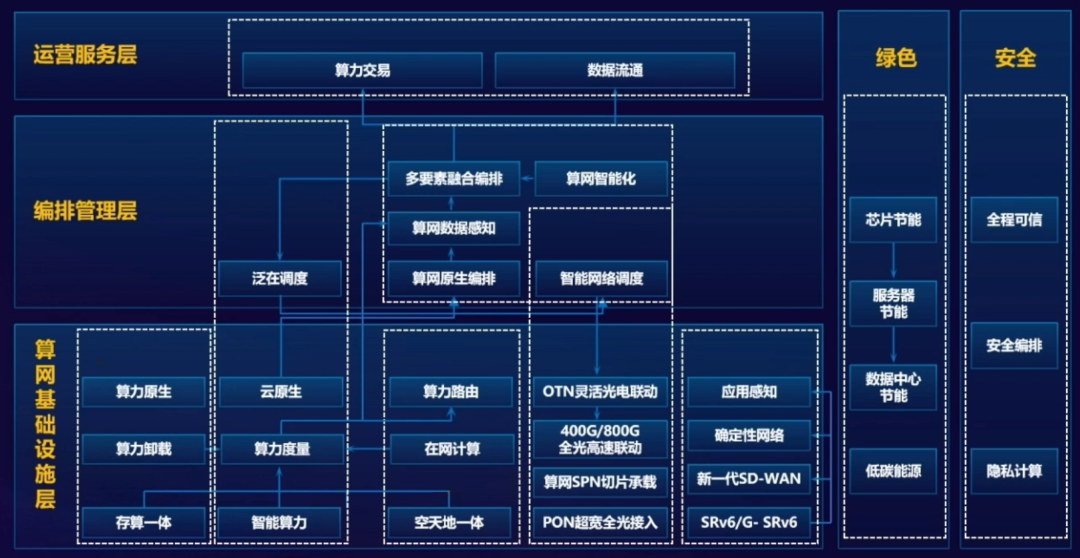
China Mobile (from White Paper on Computing Network Technology, 2022)
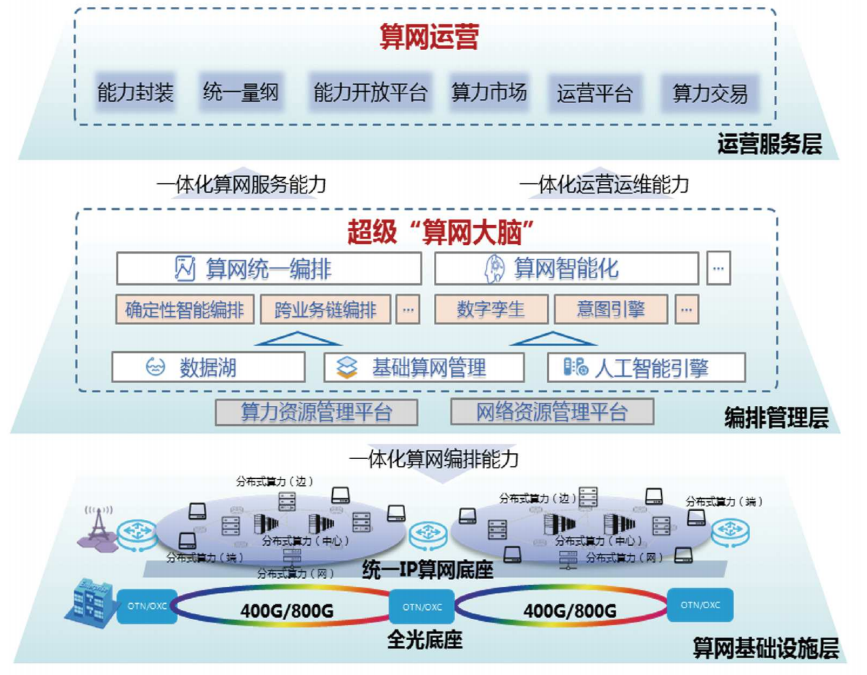
China Mobile (from "Hashpower Network White Paper")
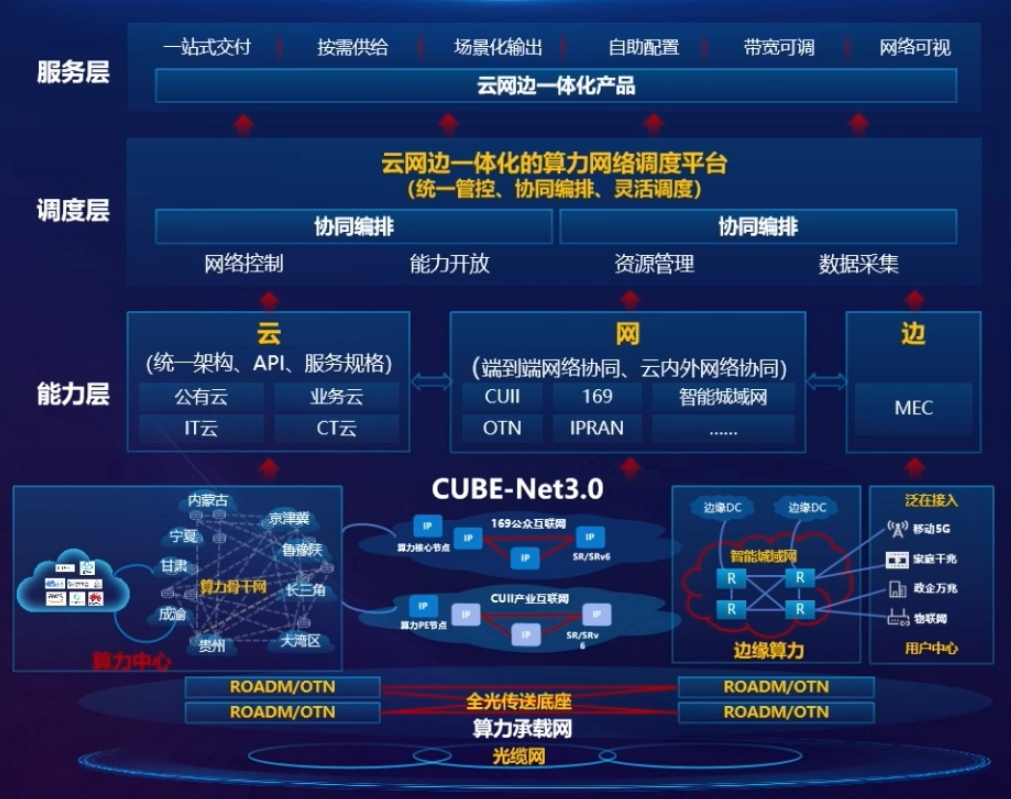
China Unicom (from Huawei WIN-WIN Innovation Week, 2022)
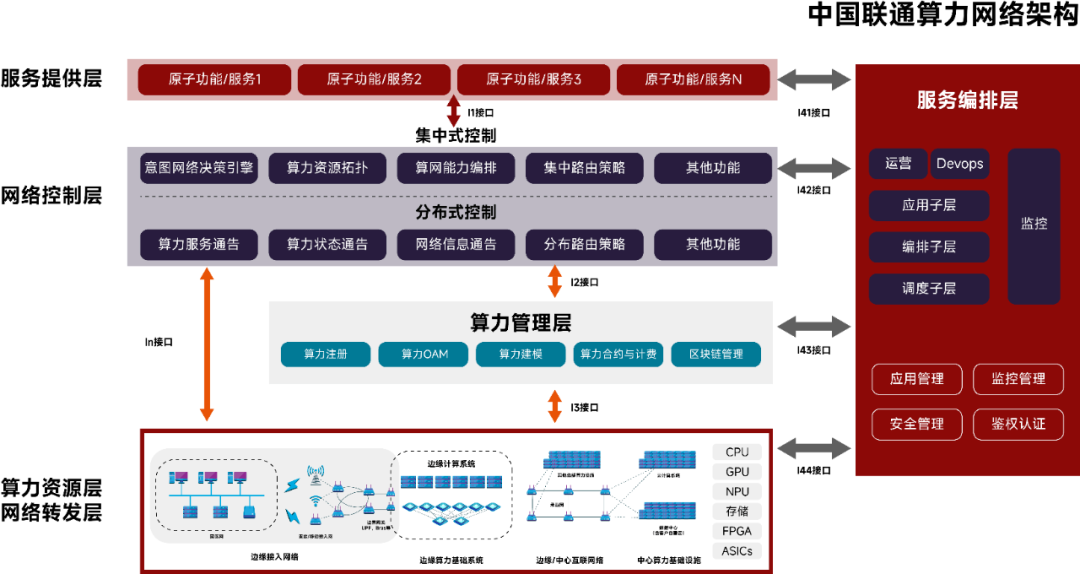
China Unicom's computing network architecture (from the "White Paper on Computing Network Architecture and Technology System")
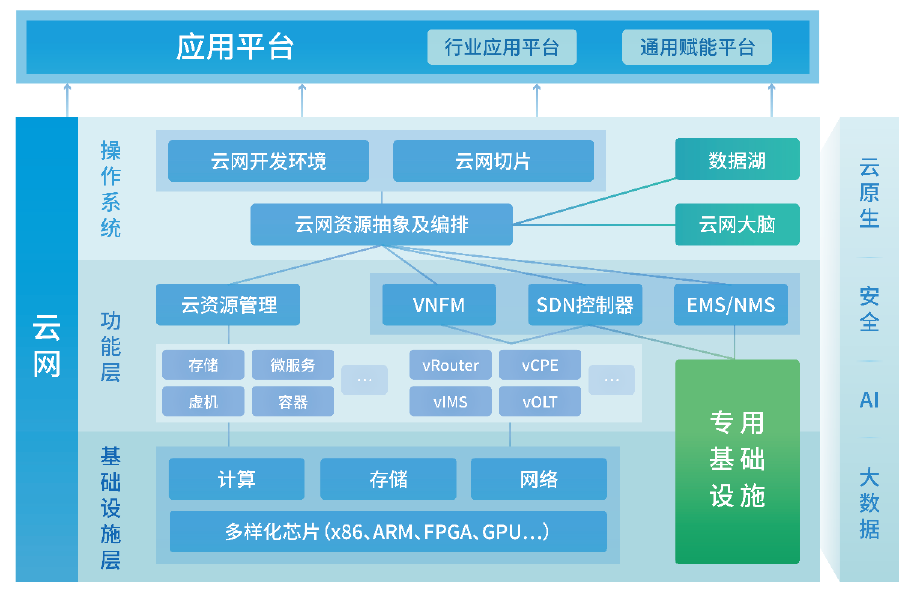
China Telecom Cloud-Network Integration Target Technology Architecture
(From "Cloud-Network Convergence 2030 Technology White Paper")
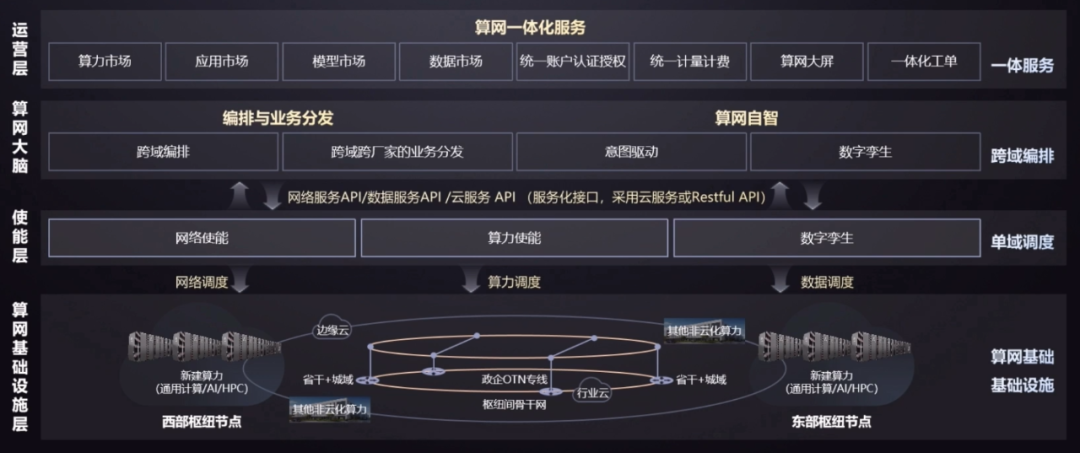
Huawei (from Huawei WIN-WIN Innovation Week, 2022)
These pictures are a bit complicated, and I believe that everyone is not very understanding. I drew a simple diagram, everyone should be able to understand:
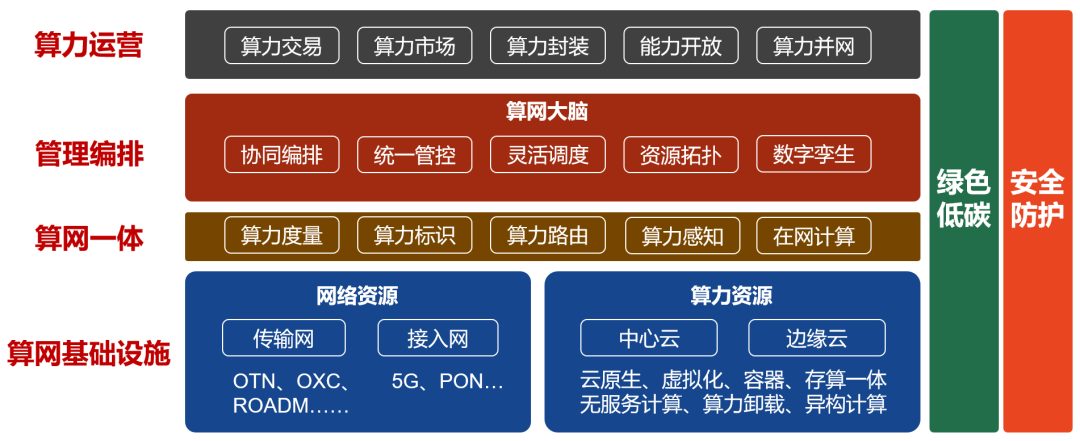
To put it simply, it is still the layered idea of information communication. Looking at the layers, the ideas can be clarified. In order to reduce the pressure of reading, you can pass the green low-carbon and safety protection on the right first.
We look at it from the bottom up, layer by layer.
Computing network infrastructure
The lowest layer of the computing power network is still the computing network infrastructure layer, which cannot be escaped. In the computing power network, the infrastructure is no longer just computing resources (CPU, storage, GPU, etc.), but also network resources.
In terms of computing resources, the integration of computing infrastructure is still centered on cloud technology, including cloud native, virtualization, and containers.
Here, some underlying new technology innovations related to computing power are also worthy of attention, such as heterogeneous computing, serverless computing, integration of storage and computing, and computing power offloading. You can leave it alone for now and introduce it later.
On the network side, the changes are relatively large. The previous articles have introduced to you that the network changes under the trend of cloud-network integration can be explained in one sentence, that is, to make the closed network more open (decoupled), so that it becomes like a computer, which can be accessed through software way (software-defined), to give it a "command".
The bottom layer of the network (physical layer, data link layer), on the transmission network side, is still light (only light can guarantee basic hard indicators such as communication bandwidth and capacity). Optical underlying technologies, such as OTN, OXC, ROADM, C+L frequency band, 400G/800G, etc., are still them, and there is no difference. On the access network side, 5G NR and PON (50G-PON) are nothing special (except that the edge computing power will be somewhat related). The big changes are in the upper layers of the network. We'll talk about that later.
Computing and network integration (computing resource management, network resource management)
Going up, things start to look different. Because the computing power network needs to schedule computing power and network resources, it is necessary to "preprocess" and "connect" the resources. (This layer, in fact, is attributed to the orchestration management in many architectures. I think it will be easier to understand if it is taken out separately.)
At this layer, the most worthy of attention is the routing of computing power.
The biggest difference between the computing power network and the traditional network is that it has three characteristics. The first major feature is computing power routing. Before computing power, let’s talk about computing power perception. Computing power perception is the network's comprehensive perception of the deployment location, real-time status, load information, and business needs of computing power resources and services. China Mobile's computing power perception network white paper is analyzed from the perspective of computing power perception.  The architecture of the computing power-aware network (from China Mobile's "Computer Power-Aware Network CAN Technology White Paper 2021"), on the one hand, each computing power node models the computing network information measurement and releases it uniformly, and the network passes the computing network information reported by multiple nodes. Aggregate to build a globally unified view of computing network status. On the other hand, the network completes the unified analysis of business computing network requirements, realizes comprehensive perception of business, and provides guarantee for computing power scheduling based on business requirements.
The architecture of the computing power-aware network (from China Mobile's "Computer Power-Aware Network CAN Technology White Paper 2021"), on the one hand, each computing power node models the computing network information measurement and releases it uniformly, and the network passes the computing network information reported by multiple nodes. Aggregate to build a globally unified view of computing network status. On the other hand, the network completes the unified analysis of business computing network requirements, realizes comprehensive perception of business, and provides guarantee for computing power scheduling based on business requirements.
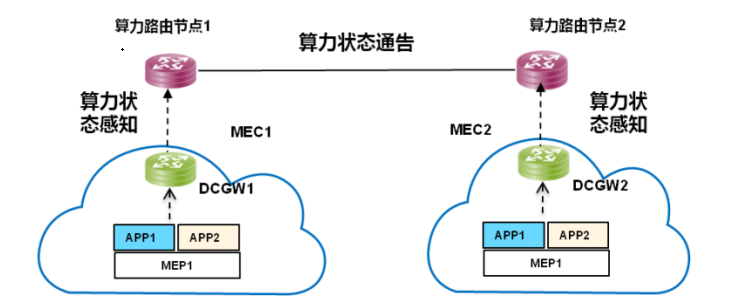
The computing power status perception and announcement (from the "Hashpower Perception Network CAN Technology White Paper 2021") put it bluntly, the purpose of computing power perception is to find out how many resources are on hand and what kind of needs of users.
Perceived objects definitely need to be measured and identified. Therefore, there is a computing power and a computing power logo.
These two pieces, operators are currently attaching great importance to.
There is diversity in computing power, and there are also heterogeneous hardware chips. Therefore, there is no unified measurement system and standard. This will cause trouble to establish a unified computing power model. Very simple, the units of measurement are different, how to evaluate and bill the computing power?
If the computing power is identified, it is equivalent to the ID card of computing power. The user indicates the required service through the computing power identification, and the network obtains the target computing power service, computing power demand and other information by analyzing the computing power identification, which provides the basis for computing power scheduling. This hashrate identification must be globally unified and verifiable.
Well, the next step is computing power routing. In the computing power-aware network architecture diagram of China Mobile just now, in addition to the computing power resource layer, there is a separate computing power routing layer.
The computing power routing layer is the core functional layer of the computing power perception network. It supports the perception and notification of multi-dimensional resources and services such as network, computing, and storage, and realizes the joint scheduling of "network + computing". The computing power routing layer, including the computing power routing control technology and the computing power routing forwarding technology, realizes the on-demand scheduling of business requests in the routing layer. When it comes to computing power routing, we must talk about CFN (Computing First Networking).
CFN is sometimes used in a broad sense to refer to the entire computing network. However, here, CFN is a distributed routing protocol that schedules and balances computing power on demand between different edge clouds.
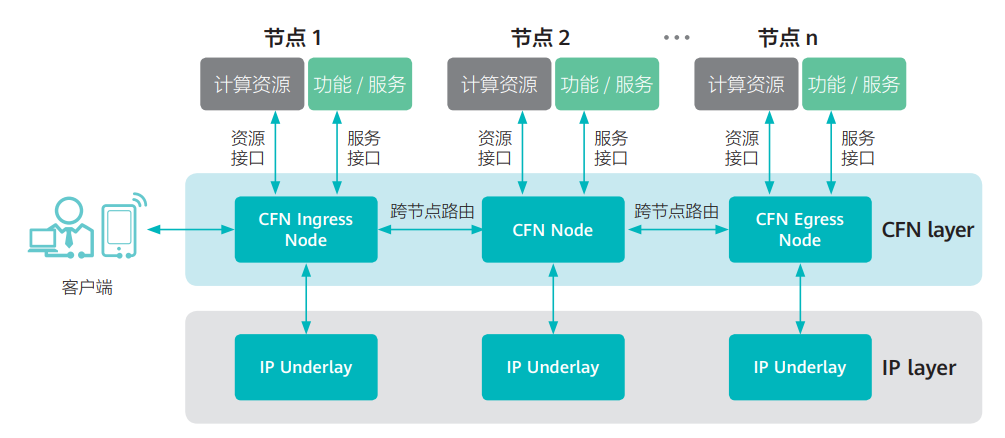
CFN technical architecture (from the White Paper on Computing Power Sensing Network Technology)
The CFN thing is actually very interesting. The routing we traditionally understand is the routing of data packets. The routing here in the CFN is to use the computing resource status and network resource status as routing information and publish it to the network. Then, the network routes the computing task packets to the most appropriate computing nodes based on the virtual service ID.
At present, the CFN protocol mainly carries the computing power information in the form of extended byte information in the BGP packet header of the service route, so as to spread the load of the computing nodes in the network to the whole network in real time.
Obviously, computing power routing and CFN are the prerequisites for the upper layer to perform computing power scheduling.
Orchestration management
Further up is the core key part of the computing power network - orchestration management. Students who have worked on core network NFV (Network Element Function Virtualization) must be very familiar with orchestration. In the NFV architecture, there is orchestration. This is a very interesting word, which has "collected and arranged" you. To put it bluntly, it is full control and scheduling. The second major feature of the computing power network is computing power scheduling. Computing power scheduling is the intelligent arrangement and flexible scheduling of computing resources of the entire network based on the computing network brain. More specifically, it is: complete computing power operation and computing power service arrangement, complete the management of computing power resources and network resources, including the perception, measurement and OAM management of computing power resources, etc.; realize computing network operation for end users , and the management of the computing power routing layer and the network resource layer. After the computing power resource is perceived, identified and perceived, in order to manage it, there is a logical process of computing power resource management (also called separately: computing power management layer). It mainly includes computing power registration, computing power OAM (performance monitoring, fault management), computing power operation (billing management, service contracts, etc.).
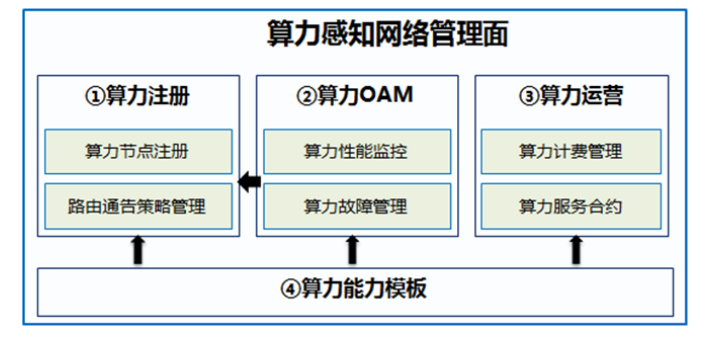

Computing power management
(From the "Hashrate Perception Network CAN Technology White Paper 2021")
This function division is very troublesome. In some operator architecture diagrams, this block is defined as the computing power management layer, which exists alone. In some architecture diagrams, there is no such layer, and it is assigned to the orchestration management layer. Therefore, each understanding is different, and it is very big. Anyway, everyone should know that there is such a functional group.
To achieve it, it must be inseparable from a "nerve center" that controls the network.
The core control part of the scheduling and orchestration network, some operators call it "the brain of the computing network".
This "computer brain" has four important functions:
- Obtain global real-time computing, network, and data resources, as well as cloud, edge, and terminal distribution, and build a global situational awareness map.
- Cross-domain collaborative scheduling intelligently and automatically decomposes multi-domain collaborative scheduling tasks to each enabling platform to realize resource scheduling of computing, network, and data.
- Multi-domain fusion orchestration, according to the multi-domain fusion business requirements, based on the atomic capabilities of computing, network, and data, flexible combination and orchestration on demand.
- Intelligent auxiliary decision-making, based on factors such as SLA requirements of different services, overall network load, and available computing resource pool distribution, intelligently and dynamically calculates the optimal collaborative strategy for computing, network, and data.
The computing network management and orchestration layer maintains the global static computing power, service and network topology information, and synchronizes it to each entry computing power routing node. The computing power routing node maintains the topology information of computing power services and the real-time status information of computing power resources and network resources, and performs computing network coordination through distributed computing power routing nodes.
The "Computer Network Brain" is the nerve center of the computing power network, and its importance is self-evident for coordinating global resources. Introducing AI artificial intelligence into the "Computer Network Brain" is definitely a needless to say. In addition to AI, operators and equipment vendors are now planning to put "digital twins" and "intent engines" in them to try their best to improve the intelligence of the "Computer Network Brain".
To be honest, looking closely at the management and orchestration layer, I have a feeling that the computing power network is the upgrade and integration of SDN and NFV technologies, and there are shadows of these two technologies everywhere. However, many other technologies are added to the surface to form a more complete and larger system.
Service operation
Above the computing power brain, is there no more? No, don't forget, we also have a service operations layer.
The service operation layer, to put it bluntly, provides an interface for upper-layer applications to manage and control the computing power network. The brain is not a real boss, but a "big housekeeper". It is the upper-layer users and applications that really control the network.
The purpose of the service operation layer is to open up the ability to provide computing power networks. Key technologies include: computing power transaction, computing power grid connection, computing power packaging, intention perception, etc.
The third major feature of the computing power network is computing power trading.

Routing, scheduling, and transactions are the three major features of the computing power network.
Computing power trading is an important innovation of the computing power network.
Before the integration of computing power and the network, the user will pay whoever uses the cloud computing, and whoever uses the communication network will pay. After the integration of the computing network, computing power is everywhere, and scheduling comes and goes. Who should you give money to?
Computing power trading is to solve this problem.
In the computing power trading scenario, there will be a trusted ubiquitous computing power trading platform.
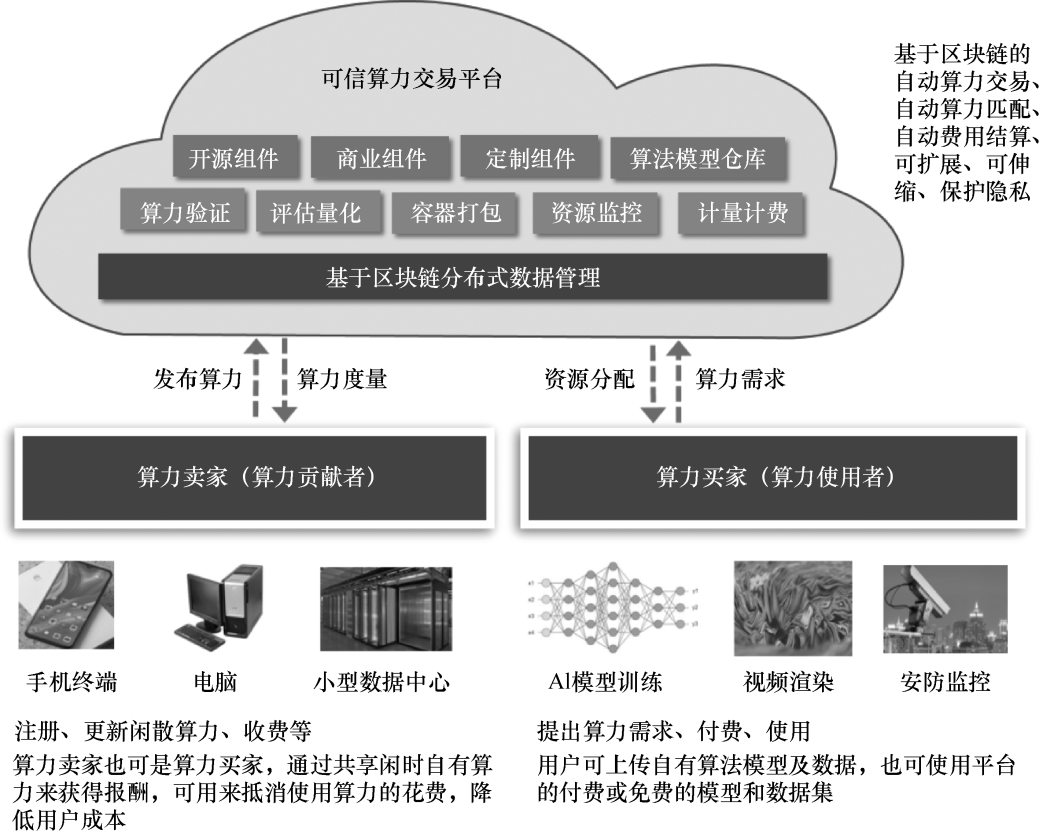
From "Hashpower Network - Network Architecture and Key Technologies in the Era of Cloud-Network Integration 2.0"
The general process is as follows:
First, the computing power consumer puts forward detailed computing power requirements. Then, the computing power trading platform integrates the available resources according to the demand to generate a computing power network resource table. According to factors such as delay and cost, there will be corresponding quotations. Next, the computing power consumer chooses a "package" that is most suitable for him according to the resource table. Then, the transaction contract is signed on the computing power trading platform. Then, the trading platform schedules resources through the computing power network according to the contract, and updates the resource information. Finally, the contract ends, the service is terminated, and resources are released.

Computing power network trading platform
(From "Integrating Multi-party Computing Networks to Achieve Optimal Utilization of Computing Resources", Leibo)
In the 21st century, whenever a transaction model is mentioned, a word must be involved—blockchain.
That’s right, the computing power trading platform also uses blockchain technology to realize functions such as distributed ledgers and anonymous transactions.
To sum up, the computing power network closely focuses on the computing power needs of users, covering the entire life cycle of computing power generation, scheduling, transaction, and consumption. What the computing power network wants to achieve is to move with people and according to "demand", so as to achieve the perfect matching of computing power supply and demand.
Standard progress of computing power network
In recent years, the computing power network has become very popular in China. Both operators and equipment manufacturers attach great importance to this concept.
Especially the domestic operators are crazy about the computing power network.
The reason is very simple. Foreign operators rarely touch the Internet. Basically, they are engaged in communication, and at most they are engaged in cloudification of traditional communication. Domestic operators, on the other hand, have both the network and the cloud, and especially hope to integrate and revitalize the resources of the network and the cloud. Moreover, our country attaches great importance to infrastructure construction, and the computing power network is an important digital infrastructure. Therefore, operators, as state-owned enterprises, also pay special attention to this accumulation.
On the one hand, in order to master the initiative of technical standards, and on the other hand, for brand promotion and image building, the three major operators began to roll up on the computing power network.
2019 is recognized as the first year of computing power network. On November 1 of this year, China Unicom took the lead and released the "China Unicom Hashpower Network White Paper" during the Beijing PT Exhibition. This is the first white paper related to computing power network in China.
Since then, domestic operators have scrambled to release a number of white papers one after another, and actively promoted the formulation of standards for computing power networks.
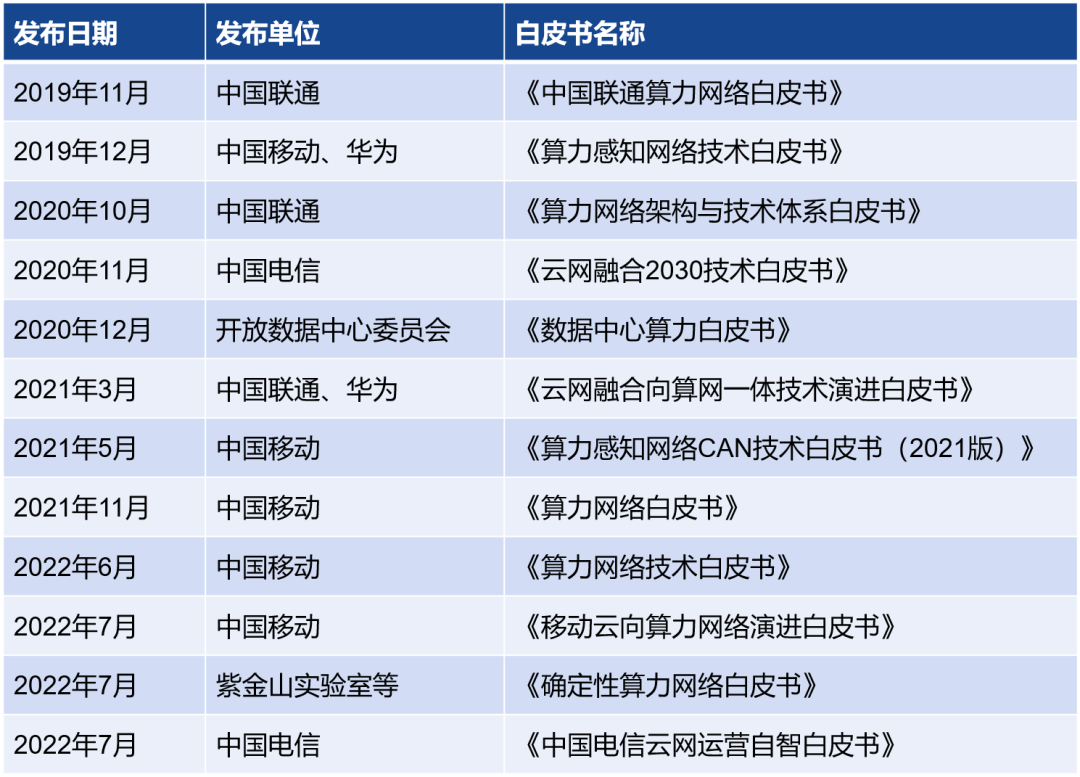
In terms of standard promotion, I have compiled a table based on the information on the Internet, which roughly records the situation of major standards organizations in the formulation of computing power network standards, for reference only:
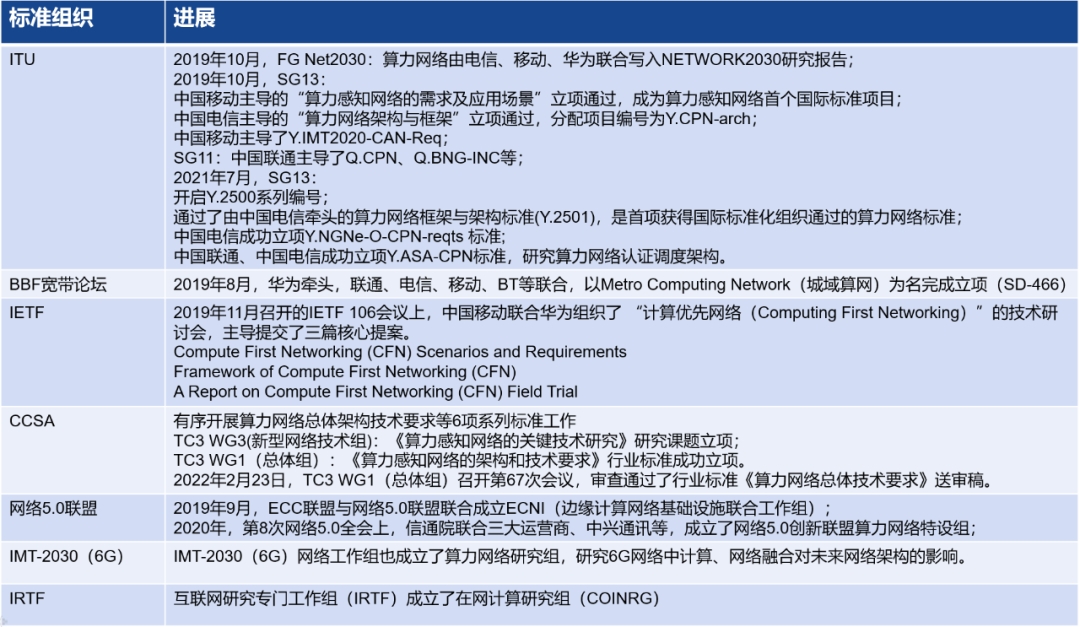
Comprehensive from CITIC Securities, major white papers, official website news
Test progress:
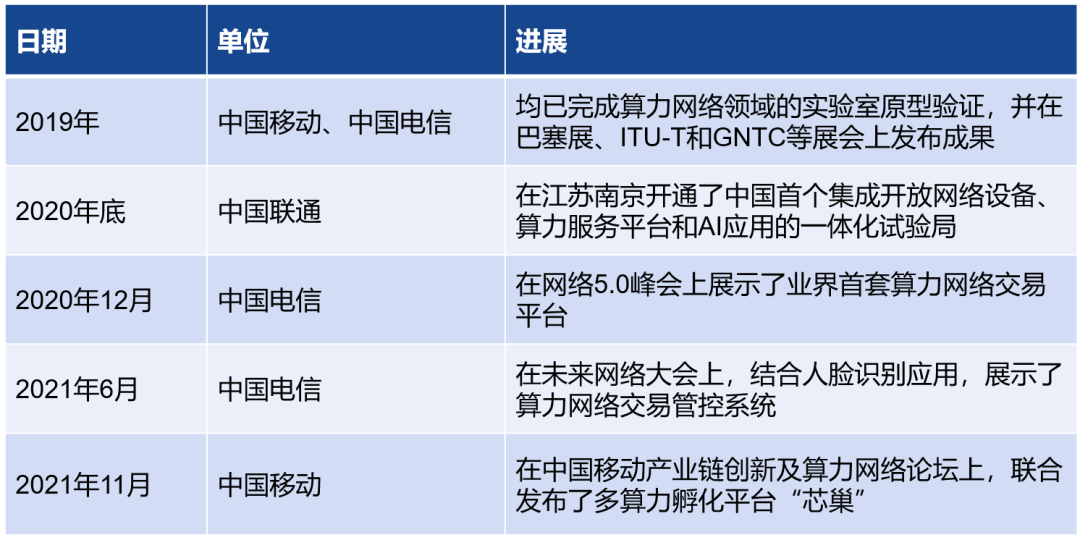
From CITIC Securities
Epilogue
From the actual situation, the computing power network is still a long way from us. At present, we are in the advanced stage of cloud-network integration, and the integration of computing and network or computing power network is still under study.
Nonetheless, there is no doubt that the computing power network will be the future development trend of computing power and connection power. The integration of computing and network is inevitable, and it is also the way back for the entire communications industry. As a "pipe", traditional communication cannot enhance its own value. Only by fully investing in the embrace of the cloud is the best way out.